
On a Saturday when the predicted rain did NOT materialize (in 2012 there has not been a drop of rain whatsoever during ForgottenTours so far) almost 30 ForgottenFans assembled at Dyckman Street and Broadway and 4 hours of Forgottening began. Humid and tropical it may have been, but we saw an area of Manhattan that few but its residents know.
Inwood is located in a fairly well-defined area: Manhattan is so narrow at its northern end that you can say that anything north of Dyckman Street is in Inwood. On a map, that works out just fine. By walking around, though, you can detect three separate sub-neighborhoods: anything east of the el on 10th Avenue is gas stations, auto repairs, and supermarket wholesalers; between 10th and Broadway are apartment houses, mom and pop shops, and bodegas; and west of Broadway is the most unusual Inwood of all, since mixed in with the apartments (some of them in gorgeous Deco) you find standalone single and two-family homes, a true rarity in Manhattan, as well as the vast, wild Inwood Hill Park.
Our first stop was a building used for a different, yet fitting, purpose than for what it was built to do.
The Packard showroom at Broadway and Sherman Avenue was designed in 1926 by architect Albert Kahn, who designed Packard showrooms across the country and, although he is now little-known, was in his day one of the highest compensated architects. Fittingly enough, it now serves as a parking garage. Packard, famed for luxury autos, was in business from 1899-1958.

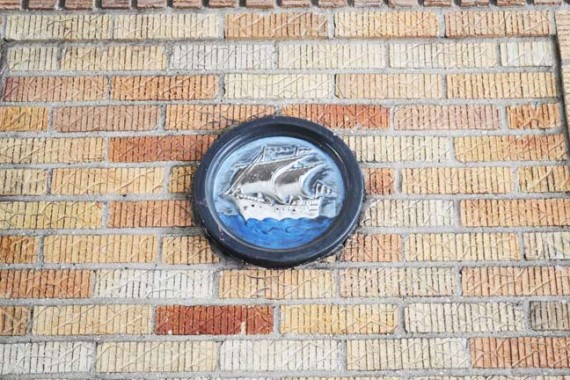

The crowd pauses inside Hawthorne Gardens on Broadway, which has likely never been a tour stop before. It is an example of the casual elegance architects imparted residential buildings until just a few years ago. These days only luxury buildings get decorative touches, and even they don’t get terra cotta panels and inner courtyards.
The Dyckman Farmhouse was the tentpole attraction on his tour. Located at Broadway and West 204th Street, it has been here since about 1785 and is Manhattan’s last remaining Colonial farmhouse. It was built by William Dyckman, grandson of Jan Dyckman, who first arrived in the area from Holland in the 1600s. During the Revolutionary War the British took over the original Jan Dyckman farmhouse; when they withdrew at the war’s end in 1783 they burned it down, perhaps out of spite.
The farmhouse was rebuilt the next year, and the front and back porches were added about 1825; the Dyckman family sold the house in the 1870s and it served a number of purposes, among them roadside lodging. The house was again threatened with demolition in 1915, but it was purchased by Dyckman descendants and appointed with period objects and heirlooms. It is currently run by New York City Parks Department and the Historic House Trust as a museum. A copy of one of the occupying British soldiers’ log huts, with a log roof, can be found at the back of the house. The cellar kitchen is particularly engaging, with old waffle irons, sausage stuffers and a child’s game board.
The house is so small on the inside that only ten of us were allowed to enter at the same time. In the 1700s, people were generally smaller than they are now, both in height and girth. Washington, at 6’4″, was a giant of his time.
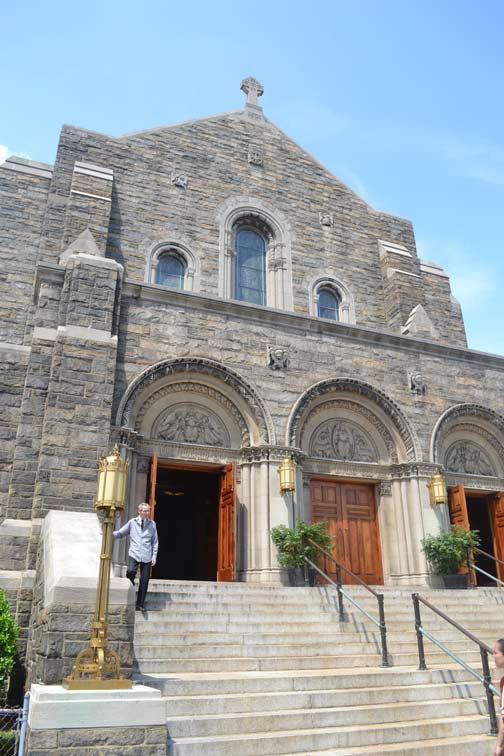
Good Shepherd Church, Broadway and Isham Street, is celebrating its 100th anniversary in 2012. The first church was a wood frame building that was moved across Cooper Street around 1930 and was later razed to make way for an addition to the elementary school.


A pair of decades-old street fixtures can be found on Broadway and Isham. A 1913 fire alarm still has the fixture that used to hold its spherical red glass lamp. And, a pole that could have been put there as early as the 1860s once held either a gaslamp or a mailbox and street sign combo.
What is likely Manhattan’s longest public staircase ascends a steep hill in the path of West 215th from Broadway west to Park Terrace East. There are 10 landings with 11 steps each. Along the way there can be found some ancient lamppost fixtures. Also note the chiseled West 215th Street sign.

The concrete arch in back of the auto body shops on Broadway and West 216th is the last remnant of the Seaman-Drake Estate. John and Valentine Seaman obtained 25 acres of land from Broadway to Spuyten Duyvil Creek and what would be West 214th-218th Streets in 1851 and set about building a hilltop mansion. The arch, 35 feet tall and 20 feet deep, meant as a gateway to the estate, was first built in 1855.
Inwood Hill Park
Inwood Hill Park is 196 acres of primordial forest (with the occasional path and rusting park lamppost). It was the site of Native American habitation; deer and raccoon were hunted for food and clothing. After the Civil War, prominent families built large mansions here overlooking the Hudson, among them Isidor Straus, who perished aboard the Titanic in 1912, and the Lord family of Lord & Taylor. The area officially became a park in 1926. The park contains the last remnant of the tidal marshes that once surrounded Manhattan Island. The marsh receives a mixture of freshwater flowing from the upper Hudson River and saltwater from the ocean’s tides. The mix of salt and fresh waters, called brackish water, has created an environment unique in the city.

Supposedly, this is the site of one of the greatest, or worst, real estate swindles in history, depending on your point of view. In 1626, the story goes, Dutch governor Peter Minuit purchased Manhattan Island here from the Weekquaeskeeks, or possibly the Canarsie or Lenape, for a collection of beads and trinkets valued at 60 Dutch guilders. Minuit is remembered by a plaza at Whitehall and South Streets all the way downtown. The Indians, however, were unaware of property rights as the Europeans thought of them and believed they were paying to enter an alliance with the Dutch.
This misunderstanding led to rancor and disputes between the colonists and Native Americans, and the last of the Lenape left Manhattan Island in 1715.

Just past the Rock, the path leads you along the hill. You will see rock formations that were dragged here by the Wisconsin Ice Sheet during the last ice age. Native rocks like this are visible in many areas in Manhattan and the Bronx, but are especially noticeable in Inwood Hill and nearby Fort Tryon and High Bridge Parks. In the natural hollows formed by the rocks, the Weekquaeskeeks found shelter, cooking clams and oysters. In the past, pottery artifacts have been found in these crevices.
These days, beer cans and the occasional needle can be found within.
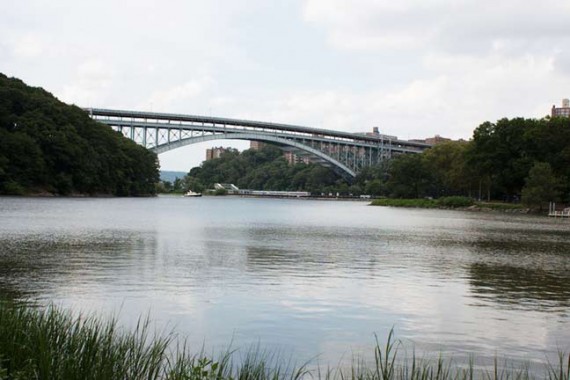
Henry Hudson Bridge. The original single-deck steel arch structure was built for the Henry Hudson Parkway Authority by the American Bridge Company at a cost of $4,949,000 and opened to traffic on December 12, 1936. The upper level was opened two years later.
A bridge at this location was proposed as early as 1906, but Spuyten Duyvil residents and other civic groups opposed the bridge, arguing that it would destroy the virgin forest of Inwood Hill Park and bring traffic congestion to the communities on the Bronx side of the river. Meanwhile, traffic czar Robert Moses preferred the route along the Hudson River because he was able to receive the land to build the Henry Hudson Parkway at no cost and use federal labor to construct the parkway. The construction of the bridge helped open the Riverdale neighborhood to development.
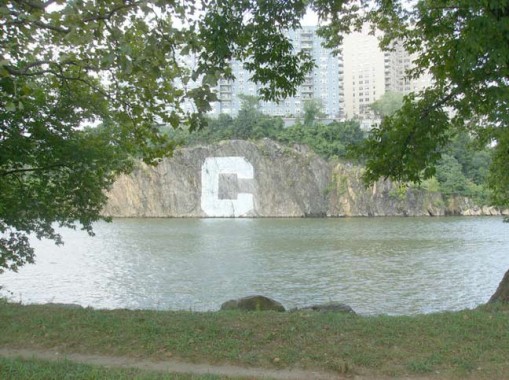
The blue and white 60-foot by 60-foot Columbia University “C” has been painted and repainted on the rock facing the Harlem River since 1952. It was originally conceived by Robert Prendergast, a medical student of Columbia University and coxswain on the heavyweight rowing crew team. Prendergast approached the New York Central Railroad for permission (which was given) to have this sign painted on the 100-foot-high wall of Fordham gneiss, which was completed in the fall of 1952 by the rowers of the crew team, which continues to maintain it.
Photos: Joe DeMarco, Bob Mulero, Emily Sharp
8/14/12

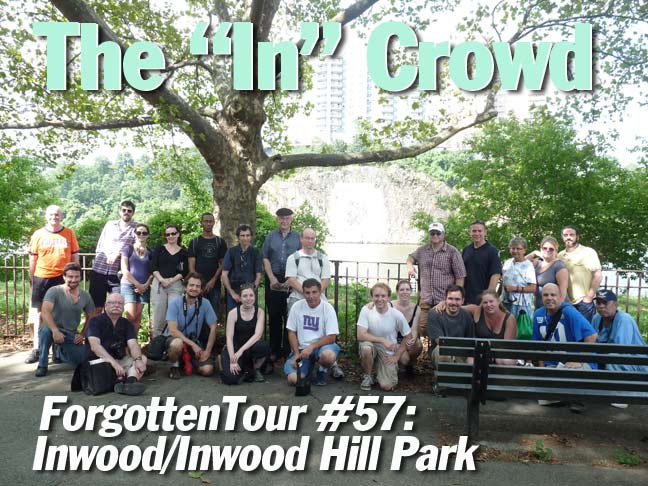
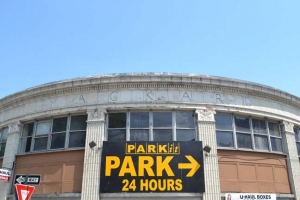
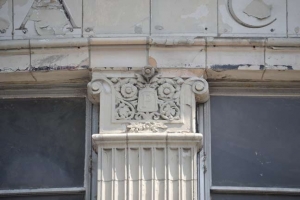
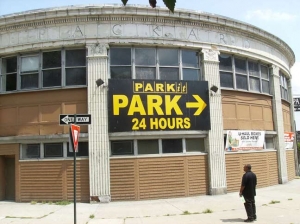
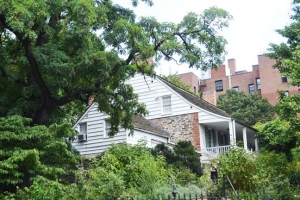
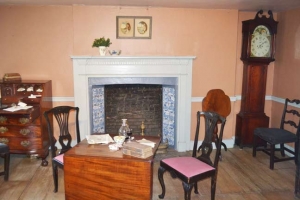

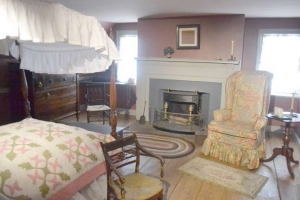
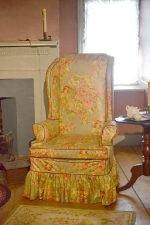
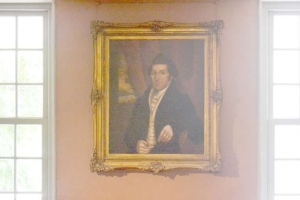
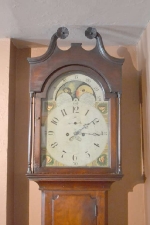
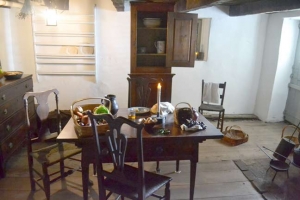

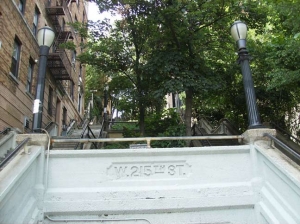
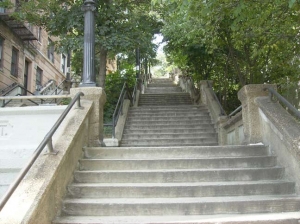

23 comments
In 2004 there was a homicide in Inwood Hill Park that remains unsolved. The story would make a terrific film, but alas, Sidney Lumet has passed & apparently there are no writers or directors of his caliber to replace him. Inwood is such an interesting place & an unsolved homicide involving a graduate student would make for some great story telling but “that’s show biz”, I guess.
My father was raised overlooking inwood park an the area. My son would be interested in providing a background music of this theme contac Shelly Townshend Skunk Production Ca Mention and tell the story and how Dan the Mu
lots of ghosts and caves in Inwood link up dfarrell1000@gmail.com and skunk productions in LA to come and so come serious music and documentary of the reagion jfar1232000@yahoo.com
Even though Inwood is part of the island of Manhattan, it can still feel like a world away with so many features you can’t find almost anywhere else on the island.
The lamppost, minus its luminaire, on Isham St. (actually W. 211 St.) and Broadway is indeed the post of a gas lamp. It is said to be the last remaining example in the city, if one discounts the fixture in Patchin Place, Greenwich Village. This latter lamp now has an electric luminaire, and I don’t believe it is in its original location. Both lamps were landmarked along with the remaining cast iron electric posts.
I think the public stairs on West 187th Street between Overlook Terrace & Fort Washington Avenue may be a little longer than the 215th Street stairs. I recently counted about 130 steps. They’re both a hike though!
> The blue and white 60-foot by 60-foot Columbia University “C” has been painted and repainted on the rock facing the Harlem River since 1952. It was originally conceived by Robert Prendergast, a medical student of Columbia University and coxswain on the heavyweight rowing crew team. Prendergast approached the New York Central Railroad for permission (which was given) to have this sign painted on the 100-foot-high wall of Fordham gneiss, which was completed in the fall of 1952 by the rowers of the crew team, which continues to maintain it.
I can’t tell you how many time we jumped from this rock into the Harlem river to put on a show for the Circle Line sight seeing boats that traversed the river and then went on to go south on the Hudson river…The boats would slow down as they approached the rock and you could hear the Captain making an announcement that if they were lucky some of the Bronx boys would put a show on for them… There were 3 different levels that you could jump from as you got more nerve you went higher. Boy what memories. jh
LOT MORE THAN 3 LEVELS
The Henry Hudson Bridge had been the engineering dissertation of David B. Steinman (who also supervised the reconstruction of the Brooklyn Bridge in the 1950s, when they removed the railroad tracks). When the City needed the bridge in the 1930s, he just pulled out his old design from 1911.
Lived around the corner from the Packard showroom & moved away in1960. If I recall correctly, there was a bowling alley in that building. Anyone remember??
As a NYPD officer working in that neighborhood I recall that building housed a bowling alley and later became a nyc welfare office sometime in the 60’s
Hi Tom! Hope you are well!
My parents were youngsters in Inwood during the 1930’s. They were married in Good Shepherd Church October 1942. My two older siblings were baptised there ’44 and ’46. They all moved out to Little Neck in 1950 where I and my younger two siblings were baptised and raised, During the 1950’s my mother’s parents lived across Broadway from the Church. We would come in about every other week. My grandfather Frank Allaire during that time was the sexton/handyman for the Church.
During WWII, when my dad was in the Army Signal Corps(film editor), he would commute daily to the Army film production site(now the Kaufman/Astoria Studios) to work on film productions for the Army.
They were known by some as subway commandos.
Inwood, for those of use who were fortunate to spend our childhoods and young adult years there, holds cherished memories of a time gone by. The park, such a big part of our growing up years, not only had the always beckoning woods, but also held tennis, handball and basketball courts. It had two softball fields, a baseball field and a Little League field. Now there is a fence surrounding the whole area, but when we were children, you could gather your friends and have an impromptu game any time you wanted. There was also a cold water fountain strategically placed just outside the backstop. The bottom of the park had what we called the Irish football fields, where you could find many a hurling player knocking each other around the field. There were swings and seesaws, sandboxes and horseshoes. Who could forget Joe’s stand, located at the entrance of the park (some had other names for the jolly old guy) with the frosty sodas and even frostier ice cream? Solitude could be found in the Indian caves, where there were no needles or beer cans. On warm summer nights people from the neighborhood could be found in the park getting what breezes could be found off the river. Inwood Hill Park was an oasis for young and old alike. I can only hope that it remains so for the current inhabitants of Inwood.
Looks like a great tour and great subject! However, you left out “Isham Park” which is joined to Inwood Hill Park along its eastern edge above Isham Street. Isham Park was a gift to New York City in 1911-12. It helped to spur the purchase of land for Inwood Hill Park by the city in 1916.
Julia Isham Taylor had the inspiration to make the gift of land for Isham Park after her father’s death in 1909. The centennial of Isham Park is to be celebrated on September 29, 1912 between 11am and 3pm. Hope you can come out and help celebrate and discover the history of this beautiful park i n the center of Inwood!
Gee, Pat, I think you meant 2012 there,LOL.
Kevin, this Forgotten tour could’ve gone on another half-page and I would’ve been ecstatic. Many years ago, though my grandparents lived in the upper Bronx, Inwood, to me, was one of the Five Towns of Long Island; I had no idea another Inwood existed in NYC. I hope you revisit this area sometime soon and feature more photographs from each of its three sub-sections.
Yes did mean 2012! It was a great event! and Inwood is also a Long Island town. Wikipedia calls the Northern Manhattan locality “Inwood, Manhattan” in order to distinguish it.
c rock had more than 3 levels
My Grandfather Raymond Fusselman lived at 270 Seaman Ave from 1934 to 1975 in a lovely two bedroom apartment. The Kitchen window overlooked the park and the Spyten Dyvl Bridge. Lovely view now the apt is going for upper of 300,000 condo. The Dodgers practiced at Columbia Field just north of the apts. Great Memories visiting the beautiful old apt. building and my wonderful Grandparents Raymond and Almeda Fusselman, Aunt Iva lived in building with her family I read Peter Hamills magical novel about early NY and had alot of history in the caves of Inwood Park.
In response to Dennis O’Connor, the Psckard dealership did become a bowling alley ” Manhattan Lanes” and later it became a Dept. Of Social Services office. The garage is still there as far as I know.
Would love to take a tour of Inwood Hill Park and see some of those caves . I grew up in Inwood but never got a chance to explore the park fully.
Luv this website. However, I am somewhat disappointed and many times appalled at the atrocious spelling and grammar used by some in this Comments section. I guess cellphones have eliminated the need to write and spell well. A shame, really.
With an entry arch like that, the Seaman-Drake Estate. must have been really something. Such a shame things like that have to disappear. I would have loved to have seen that in its hay day!!!
I lived on Park Terrace West and then West 211st street until I was 16. The parks were our playground all the way to the Cloisters.